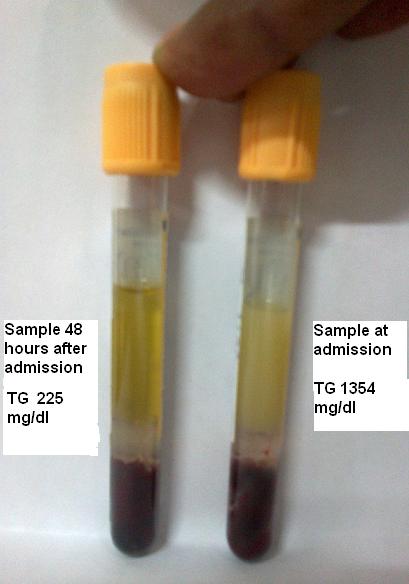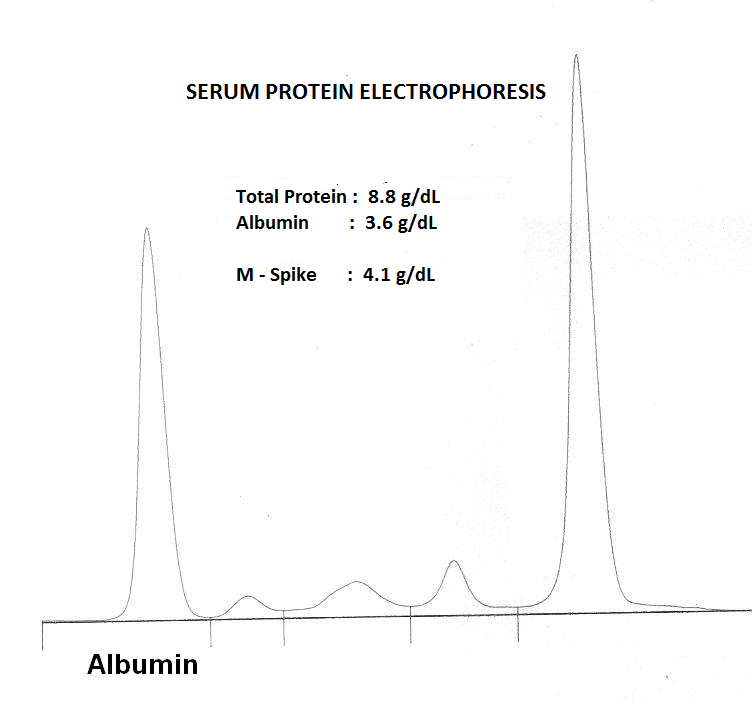Case: A member of the technical staff informed the author that he had encountered a problematic sample. The technician stated that on centrifuging the sample (that had been collected in a gel vacutainer tube), proper separation of the cells and the serum did not occur (Figure 1, left side). He was advised to (1) order a repeat collection and (2) centrifuge the redrawn sample in the gel tube at a higher centrifugal force. Normally in the author’s lab gel tubes are centrifuged at 1300 g for 10 minutes as recommended by the gel tube manufacturer. Indeed, the second sample was centrifuged at 1800 g for 15 minutes but improper separation occurred again (Figure 1, right side). The patient was a 62 year old male who had had a blood sample drawn for a serum ferritin level as he was being evaluated for anemia.
Centrifugal force has commonly been regarded as a cause of incomplete separation of samples in gel tubes (Burns DE et. al, Clinical Chemistry 2011; 57:1620-1621). However in this case, why didn't the sample separate properly even after increasing the centrifugal force?

Gel tube vacutainers are commonly used in clinical labs. The basic principle is gradient density centrifugation using the thixotropic property of the gel, where the gel forms a barrier separating the serum from the cells. These tubes have made analysis and storage of most samples easier eliminating the need for the transfer of the serum into secondary tubes. It should be noted, however, that samples used for the measurement of lipid-soluble (lipophilic) drugs should either be (1) drawn into tubes without a gel separator or, (2) if a gel separator tube is used, after the sample is drawn, the tube should be centrifuged and separated as soon as possible to avoid adsorption of the drug into the gel.
Occasionally incomplete separation of the serum and the cells is seen in some samples as a result of low centrifugal force. In the present case, the repeat sample also did not separate correctly after being centrifuged at a higher speed and this phenomenon created suspicion.
Viscosity of serum can be an important factor in the process of gradient centrifugation in gel tubes. Protein is the most important substance responsible for the viscosity of serum. Hence total protein and albumin were assayed in the patient. The total protein was 8.8 g/dL (RI: 6.5-8.5 g/dL) and the albumin was 3.6 g/dL (RI: 3.5-5.0 g/dl). As there was a sharp reversal in normal albumin/globulin ratio, serum protein electrophoresis (SPE) was performed. A band-of-restricted mobility was noted in the gamma region on SPE (Figure 2). Serum immunoglobulins were quantified which revealed a greatly elevated IgG along with low normal IgA and IgM levels. Immunofixation electrophoresis proved that the band-of-restricted mobility was an IgG kappa monoclonal paraprotein. The patient was advised to undergo a bone marrow aspiration and biopsy but due to financial reasons he was lost to follow-up.
Discussion: Ouweland et al. described two cases of impairment of proper gel separation in two patients with multiple myeloma. In both of these cases very high levels of total protein were noted (>13 g/dL) along with elevated plasma viscosity. The nature of the paraprotein in these two cases was IgG kappa and IgA kappa, respectively. The authors highlighted the fact that visual checks to determine the adequacy of barrier formation after centrifugation might help to identify such cases. (1) A study by Fatas and colleagues demonstrated that the density of plasma was a more important factor than viscosity in causing improper separation. (2)
Although these previous studies reported higher total protein concentrations than the present case, it appears that even total protein levels of 8.8 g/dL in the presence of a monoclonal gammopathy may lead to a failure of separation. Thus it appears that the concentration of the monoclonal paraprotein is important in influencing viscosity and is probably responsible for such a phenomenon. Hence laboratorians should consider the necessity of reflex testing for total protein and albumin if there is incomplete separation of serum or plasma as noted in the gel tube.

References:
1) Ouweland JMW, Church S. High total protein impairs appropriate gel barrier formation in BD Vacutainer blood collection tubes. Clin Chem 2007;53:364-365.
2) Fatas M, Franquelo P, Franquelo R.Anomalous Flotation of Separator Gel: Density or Viscosity? Clin Chem 2008; 54:771-772.